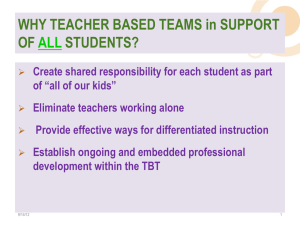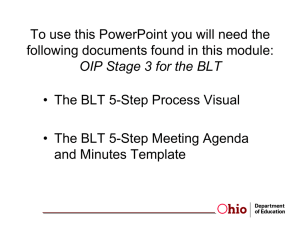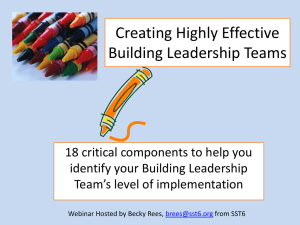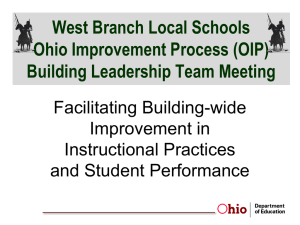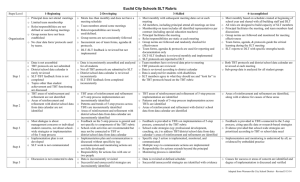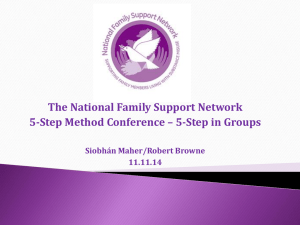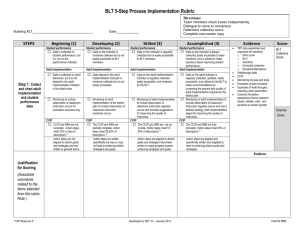Ensuring Effective Shared Leadership Practices
advertisement
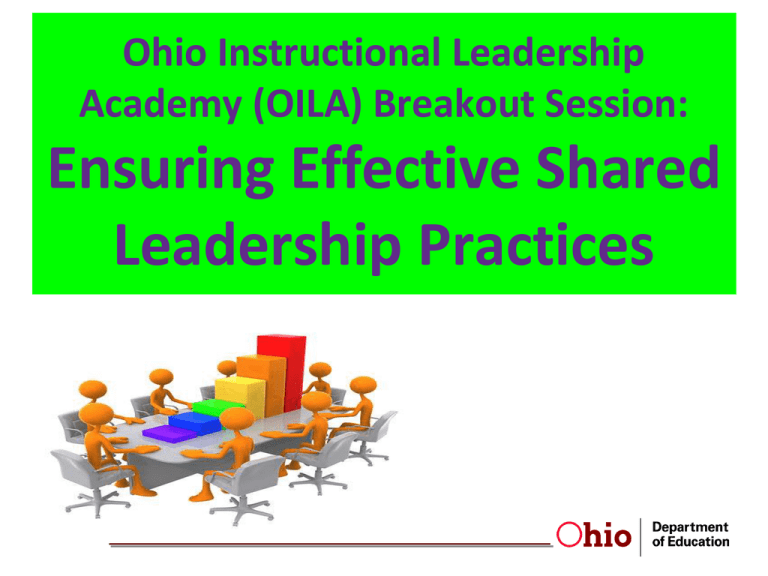
Ohio Instructional Leadership Academy (OILA) Breakout Session: Ensuring Effective Shared Leadership Practices OUTCOMES To understand student achievement and growth improve only when adult practices improve To understand development and implementation of effective Building Leadership Teams (BLTs) To understand development and implementation of effective Teacher Based Teams (TBTs) To identify and use OLAC and OIP resources available The Ohio Improvement Process (OIP): Four Stages of Continuous Improvement Stage 0: Planning and Preparing for the Ohio Improvement Process STAGE 1: IDENTIFY CRITICAL NEEDS in DISTRICT and BUILDINGS DATA -ask and answer essential and probing questions to identify strengths, needs and causes DECISION FRAMEWORK Curriculum and Instruction Assessment Processes Culture Decision Student Academic Performance and Growth Instructional and Administrative Staff Data Framework Discipline Attendance Graduation Drop-out Shared Leadership Practices Infrastructure and Systems STAGE 2: DEVELOP FOCUSED PLAN Produce one focused, integrated plan that directs all district and/or building work and resources Goals Strategies Action Steps Indicators Outcomes of Stage 2 The DLT will develop: SMART Goals o One or two Student Performance o One Climate/Conditions 2-3 research-based Strategies for each Goal Adult Implementation and Student Performance Indicators for every Strategy The BLTs will: Implement the District OIP Plan with fidelity using building data and processes Develop building-level Action Steps and Tasks to support Strategies Stage 3: Implement and Monitor the OIP Focused Action Plan Implementation Carry out the planned strategies and actions with fidelity Monitoring Ensure that both adults and students fulfill focused action plan expectations Stage 4: Evaluate the Improvement Plan and Process Outcomes of Stage 4 Identify and apply lessons learned Compare projected results with actual results Identify strategies and actions with greatest impact Assess which adult practices impact student performance Extend successes and eliminate unsuccessful practices Benefits of the Ohio Improvement Process Reduces Duplication of Effort Focuses on student success not programs Streamlines processes and procedures Promotes shared leadership and collaboration at all levels Builds personnel capacity Sustains entire system as learning organization THE QUESTION WE NEED TO ANSWER: What can we learn together about improving student achievement? Leadership practices that contribute to better instruction: 1. Focusing on goals and expectations for student achievement 2. Creating structures and opportunities for teacher collaboration 3. Attending to teachers’ professional development needs Leadership and Learning Center from Wahlstrom K. L . et. al. 2010 District/Community School Leadership Teams Building Leadership Team Teacher Based Team Teacher Based Team Teacher Based Team Building Leadership Team Teacher Based Team Teacher Based Team Teacher Based Team DLT/ CSLT BLT TBT • Build Capacity to Train TBTs in Ohio 5-Step Process • Provide TBT Training in Ohio 5-Step Process • Collect Data on Quality of TBT Implementation • Set Benchmark Standards • Use BLT Student Performance and Adult Implementation Data to Provide Guidance and Support to BLTs • Determines district wide and/or building-to-building support needed from internal and external sources • Monitor TBT Implementation and instructional practices • Use the data to make decisions around professional development and other supports needed by TBTs • Identify Strengths and Weaknesses of TBT Student Data • Provide timely flow of BLT Data to DLT Level (as defined by DLT) • Articulate roles and responsibilities of BLT to building staff • Give common assessment to students • Analyze results • Use assessment data to group students by needs or deficit skills • Provide intervention/enrichment- by differentiating instruction • Re-assess students, evaluate effectiveness of practices • Summarize student performance and instructional practice data and report to BLT DLT/ CSLT BLTs TBTs TEACHER BASED TEAMS in Support of All Students? Create shared responsibility for each student as part of “all of our kids” Eliminate teachers working alone Provide effective ways for differentiated instruction Establish ongoing and embedded professional development within the TBT A growing body of evidence suggests that when teachers collaborate to pose and answer questions informed by data from their own students, their knowledge grows and their practice changes. David, J.L., (2008/2009). What the research says about … Collaborative inquiry, Educational Leadership, ASCD, Alexandria, VA With a balance of administrative support and pressure, teacher groups are more likely to persist with addressing problems long enough to make a causal connection between instructional decisions and achievement gains. Gallimore et. al 2009 Teacher Implementation related to Student Achievement 100% % of Teachers Implementing with Fidelity 90% 80% 70% 60% 50% 40% 30% 20% 10% Student Scores Teacher Based Teams Responsibilities Improve instructional practices by following the Ohio 5-Step Process Report results to the Building Leadership Team (BLT) Share work and celebrate successes Non-negotiables for Implementing Effective Teacher Based Teams 1. Team structure for collaboration 2. Common focus 3. Shared formative assessments 4. 5-Step Process as a protocol Team Structure for Collaboration Example TBT Norms Start on time; end on time. Come prepared and ready to work. No personal electronic devices. Seek to understand before being understood. Offer constructive criticism for ideas, not fellow team members. Keep focus on teaching and learning through the 5-Step Process. Example TBT Roles FACILITATOR: Directs the procedures to be used in the meeting, and maintains a focus on one content and one process at a time. TIMEKEEPER: Monitors the use of time as allocated in the agenda. RECORDER: Takes electronic minutes of the meeting using the district-designated agenda, and reports meeting minutes to BLT, Principal, staff members, etc. per building/ district process. PROCESS FACILITATOR: Ensures the team follows the intended protocol/process. Grade Level Teacher Based Teams Cross Content Subject Area Vertical TBTs should include ALL instructional personnel, including Intervention Specialists Four Corners Discussion Activity 1. Grade Level TBTs 2. Content Area TBTs 3. Subject Area TBTs 4. Vertical TBTs Post answers on poster following group discussion Common Focus Content and/or Skills CONTENT SKILLS What students need to KNOW What students need to be able to DO Handout: Using Ohio’s New Learning Standards Take out the representative set of standards from 9th grade Identify the verbs because those are typically skills Discuss what is common across the different content areas Shared Formative Assessments Formative or Summative? It’s all in the use! Importance of Common Formative Assessments (CFA) “Schools with the greatest improvements in student achievement consistently used common assessments.” Douglas Reeves, 2004 Effect Size on Feedback .73 Hattie 2009 Hattie describes feedback….. “Feedback is not something teachers provided to students…. It was only then when I discovered that feedback was most powerful when it is from the student to the teacher… When teachers seek, or at least are open to, feedback from students as to….what students know, what they understand, where they make errors, when they have misconceptions, when they are not engaged….then teaching and learning can be synchronized and powerful. Feedback to teachers helps make learning visible.” Hattie 2009, pg. 173 Effect Size on Formative Evaluation! 0.90 Hattie 2009 Powerful Research Five reviews synthesizing 4,000 research studies conducted over 40 years concluded: “When well-implemented, formative assessment can effectively double the speed of student learning.” Dylan William, Education Leadership, December 2007/January 2008, p. 36 Tools for Understanding Formative Assessments Battelle for Kids: Formative Instructional Practices (FIP) Modules http://portal.battelleforkids.org/FIPOhio /fip-home?sflang=en The 5-Step Process Is the Protocol Why the Urgent Need for Collaboration? • Implementing Ohio’s New Learning Standards • Transitioning to Next Generation of Assessments • Implementation of OTES and OPES • Accountability of New Report Cards • Closing the Gaps OLAC Video: Ohio’s 5Step Process Step 1 Collect and chart data Step 5 Collect, chart and analyze post data The Ohio 5-Step Process: A Cycle of Inquiry Step 4 Implement changes consistently across all classrooms Step 2 Analyze student work specific to the data Step 3 Establish shared expectations for implementing specific effective changes in the classroom TBT 5-Step Process Meeting Agenda Template How Effective Is Your TBT in Using the 5-Step Process? Use the TBT 5-Step Process Rubric For determining your baseline behaviors as a team For benchmarking your improvement as a team Building Leadership Teams Responsibilities Develop, implement, and monitor the focused building improvement plans Build a school culture that supports effective data-driven decision making Ensure conditions for, support and monitor Teacher Based Teams Report building-level adult and student results to DLT and TBTs Establish priorities for instruction and achievement aligned with district goals Monitor and provide effective feedback on adult implementation and student progress using the Ohio 5-Step Process Make recommendations of resources, time, and personnel to meet district goals BLT Membership Guidance Counselor ELL Specialist Other Stakeholder Relationship of Building-level Teams BLT RtI PBIS Step 1: Collect and chart adult implementation and student performance data Step 5: Define adult implementation and student performance data for review at next meeting Step 4: Establish buildingwide implementation and monitoring actions steps/tasks for Step 3 The Ohio BLT 5-Step Process: A Cycle of Inquiry Step 2: Analyze adult implementation and student performance relative to the data Step 3: Review and/or refine the building action steps relative to the data and BLT needs BLT 5-Step Process Meeting Agenda and Minutes Template How Effective Is Your BLT? Use the draft BLT Practice Profile For determining your current level of performance as a shared leadership team For identifying strategies and action steps for improvement Using the BLT Practice Profile As a team, review one area of the “Target Performance” column Think about your BLT relative to the “Target Performance” expectations Determine two ways you will use the information from the draft BLT Practice Profile before our next session Support from OLAC/OIP Website Ohio Leadership Advisory Council (OLAC) www.ohioleadership.org Modules on Ohio Shared Leadership Framework components Training OIP Modules Navigating the OLAC/OIP Website Before our next session… Use the OLAC/OIP Website Online Help Guide to explore various OLAC/OIP online resources at www.ohioleadership.org Be prepared to share out how your BLT and/or TBTs improved their shared leadership practices based on module content OLAC Video: “Responsibility of the Building Leadership Team” Thanks for Being Such a Great Group!
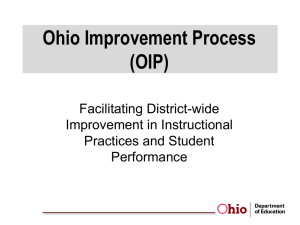
![Leadership Network [ppt]](http://s2.studylib.net/store/data/005345384_1-50a85a712e535bea3b610edb05a930c6-300x300.png)
